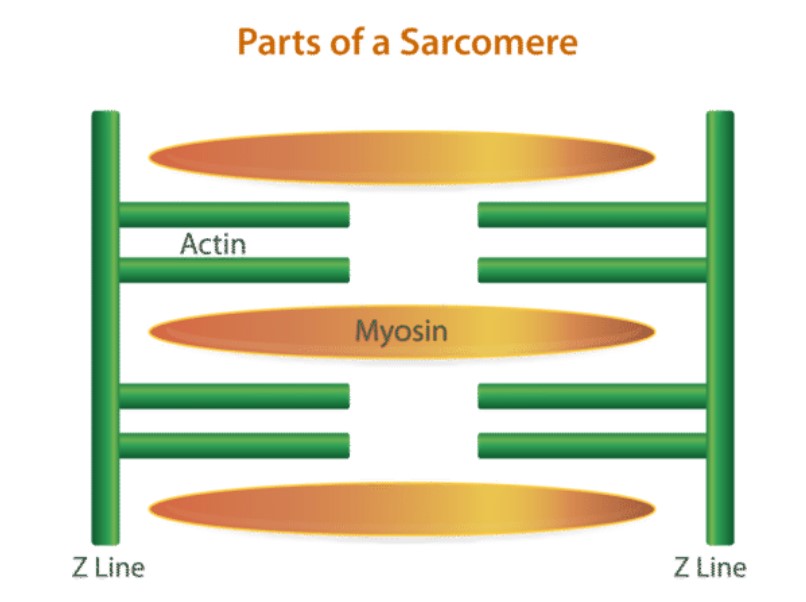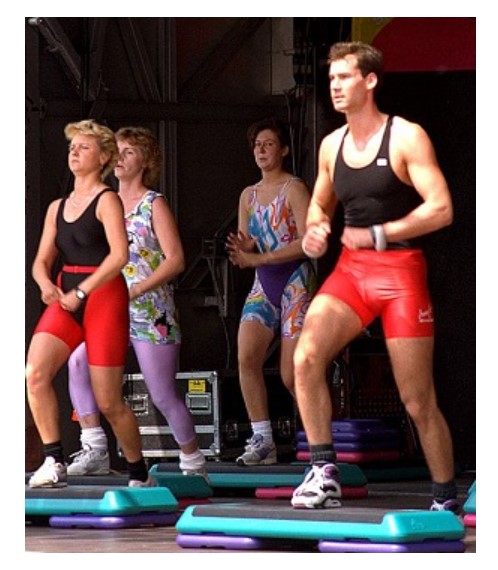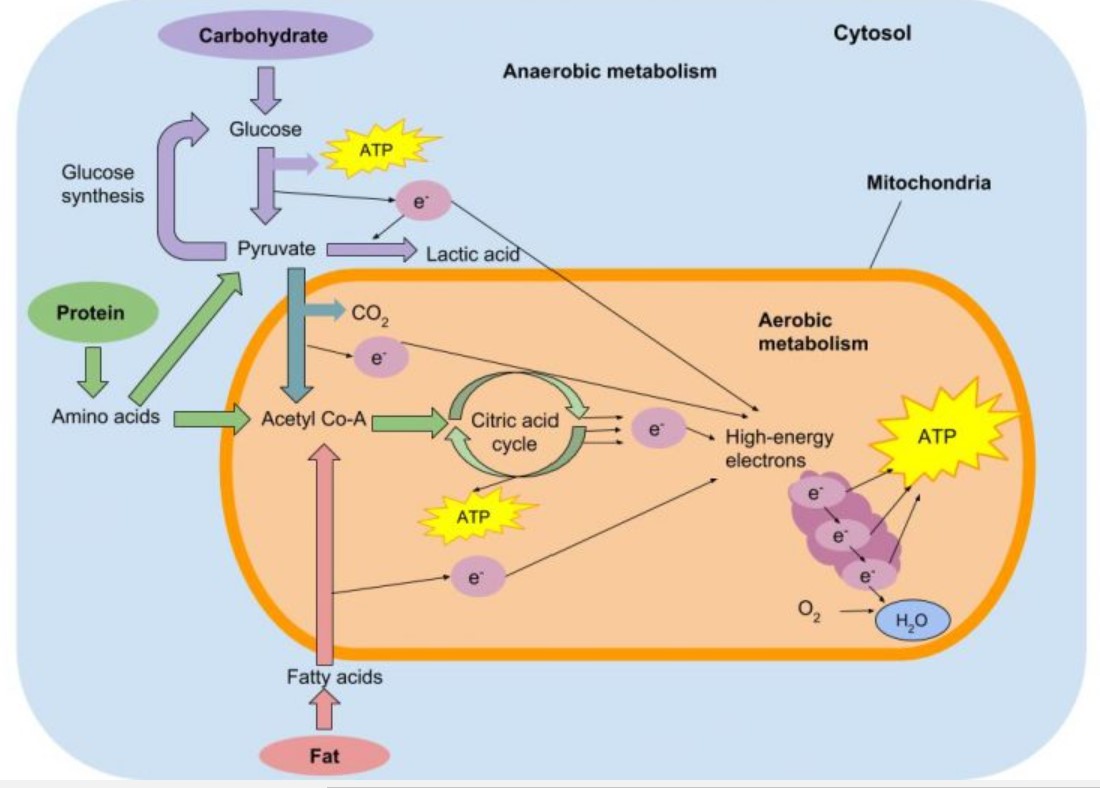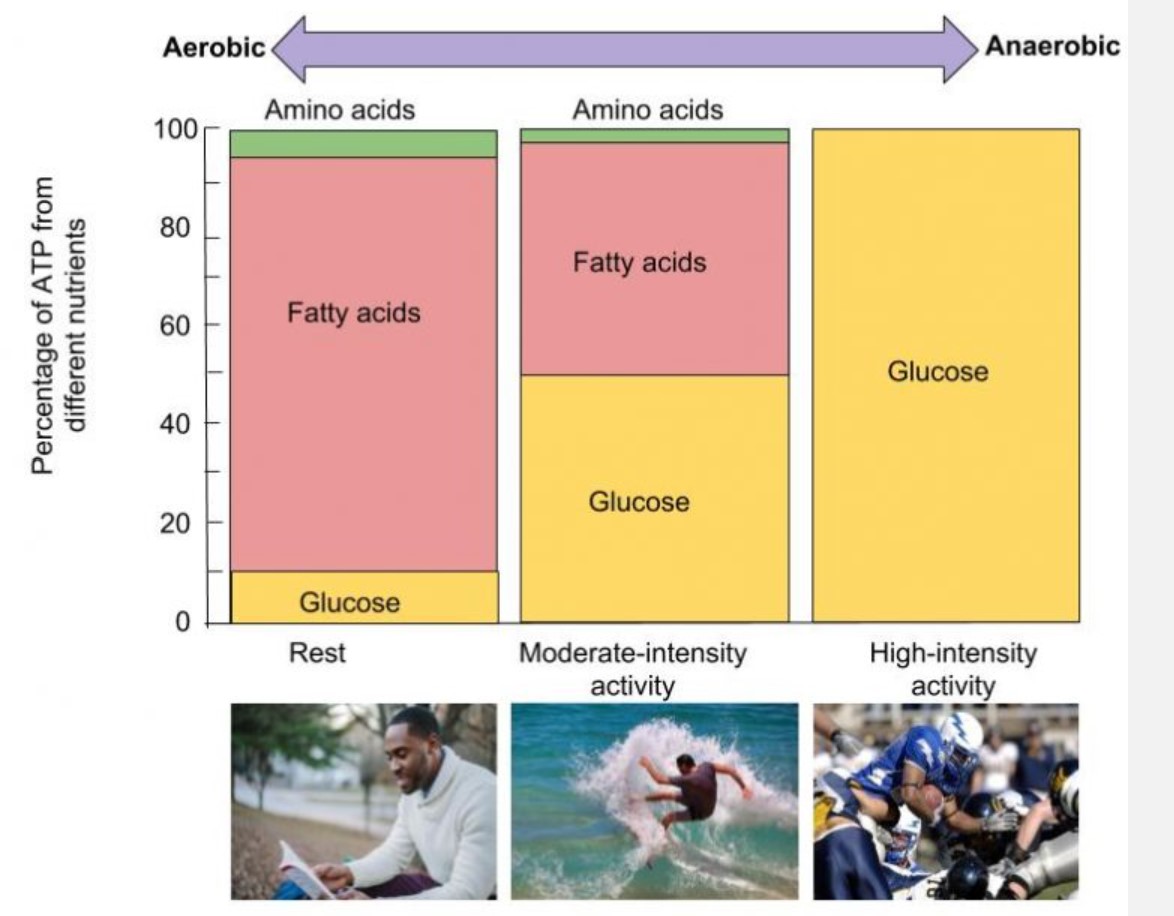In Order for Muscle to Continue Contracting During Anaerobic Fermentation
17.5: Some Muscular Chemistry
- Page ID
- 304016
- Describe how muscle contraction occurs.
- Explain the difference between aerobic and anaerobic exercise.
Muscle cells are specialized for contraction. Muscles allow for motions such as walking, and they also facilitate bodily processes such as respiration and digestion. The body contains three types of muscle tissue: skeletal muscle, cardiac muscle, and smooth muscle (Figure \(\PageIndex{1}\)).
Skeletal muscle tissue forms skeletal muscles, which attach to bones or skin and control locomotion and any movement that can be consciously controlled. Because it can be controlled by thought, skeletal muscle is also called voluntary muscle. Smooth muscle tissue occurs in the walls of hollow organs such as the intestines, stomach, and urinary bladder, and around passages such as the respiratory tract and blood vessels. Cardiac muscle tissue is only found in the heart, and cardiac contractions pump blood throughout the body and maintain blood pressure.

Muscle Contraction
Muscle contraction occurs when muscle fibers get shorter. Literally, the muscle fibers get smaller in size. To understand how this happens, you need to know more about the structure of muscle fibers.
Structure of Muscle Fibers
Each muscle fiber contains hundreds of organelles called myofibrils. Each myofibril is made up of two types of protein filaments: actin filaments, which are thinner, and myosin filaments, which are thicker. Actin filaments are anchored to structures called Z lines (Figure 13.13.2). The region between two Z lines is called a sarcomere. Within a sarcomere, myosin filaments overlap the actin filaments. The myosin filaments have tiny structures called cross bridges that can attach to actin filaments.

Sliding Filament Theory
The most widely accepted theory explaining how muscle fibers contract is called the sliding filament theory. According to this theory, myosin filaments use energy from ATP to "walk" along the actin filaments with their cross bridges. This pulls the actin filaments closer together. The movement of the actin filaments also pulls the Z lines closer together, thus shortening the sarcomere.
When all of the sarcomeres in a muscle fiber shorten, the fiber contracts. A muscle fiber either contracts fully or it doesn't contract at all. The number of fibers that contract determines the strength of the muscular force. When more fibers contract at the same time, the force is greater.
Muscles and Nerves
Muscles cannot contract on their own. They need a stimulus from a nerve cell to "tell" them to contract. Let's say you decide to raise your hand in class. Your brain sends electrical messages to nerve cells, called motor neurons, in your arm and shoulder. The motor neurons, in turn, stimulate muscle fibers in your arm and shoulder to contract, causing your arm to rise. Involuntary contractions of cardiac and smooth muscles are also controlled by nerves.
Energy for Muscle Contraction: ATP
The source of energy that is used to power the movement of contraction in working muscles is adenosine triphosphate (ATP) – the body's biochemical way to store and transport energy. ATP provides the energy for cross-bridge formation and filament sliding. However, ATP is not stored to a great extent in cells.

All muscle cells have a little ATP within them that they can use immediately – but only enough to last for about 3 seconds!
So once muscle contraction starts, the making of more ATP must start quickly. Since ATP is so important, the muscle cells have several different ways to make it. These systems work together in phases. The three biochemical systems for producing ATP are, in order:
- Creatine phosphate can supply the energy needs of a working muscle at a very high rate, but only for about 8–10 seconds.
- Glycogen is then used to make ATP from glucose. But this takes about 12 chemical reactions so it supplies energy more slowly than from creatine phosphate. It's still pretty rapid, though, and will produce enough energy to last about 90 seconds. Oxygen is not needed – this is great, because it takes the heart and lungs some time to get increased oxygen supply to the muscles. A by-product of making ATP without using oxygen is lactic acid. You know when your muscles are building up lactic acid because it causes tiredness and soreness – the stitch.
- Within two minutes of exercise, the body starts to supply working muscles with oxygen. When oxygen is present, aerobic respiration can take place to break down the glucose for ATP. This glucose can come from several places:
- remaining glucose supply in the muscle cells
- glucose from food in the intestine
- glycogen in the liver
- fat reserves in the muscles
- in extreme cases (like starvation), the body's protein.
Aerobic respiration takes even more chemical reactions to produce ATP than either of the above two systems. It is the slowest of all three systems – but it can supply ATP for several hours or longer, as long as the supply of fuel lasts.
Aerobic Exercise: Plenty of Oxygen
Aerobic exercise (also known as cardio) is physical exercise of low to high intensity that depends primarily on the aerobic energy-generating process. Aerobic literally means "relating to, involving, or requiring free oxygen", and refers to the use of oxygen to adequately meet energy demands during exercise. Generally, light-to-moderate intensity activities that are sufficiently supported by aerobic metabolism can be performed for extended periods of time. When practiced in this way, examples of cardiovascular/aerobic exercise are medium to long distance running/jogging, swimming, cycling, and walking, according to the first extensive research on aerobic exercise, conducted in the 1960s on over 5,000 U.S. Air Force personnel by Dr. Kenneth H. Cooper.

Cardio
Kenneth Cooper was the first person to introduce the concept of aerobic exercise. In the 1960s, Cooper started research into preventive medicine. He became intrigued by the belief that exercise can preserve one's health. In 1970 he created his own institute (the Cooper Institute) for non-profit research and education devoted to preventive medicine. He sparked millions into becoming active and is now known as the "father of aerobics".
What is generally called aerobic exercise might be better termed "solely aerobic", because it is designed to be low-intensity enough not to generate lactate (or lactic acid), so that all carbohydrate is aerobically turned into energy.
Initially during increased exertion, muscle glycogen is broken down to produce glucose, which undergoes glycolysis producing pyruvate (Figure \(\PageIndex{4}\)) which then reacts with oxygen(Krebs cycle, Chemiosmosis) to produce carbon dioxide and water and releases energy. As glycogen levels in the muscle begin to fall, glucose is released into the bloodstream by the liver, and fat metabolism is increased so that it can fuel the aerobic pathways. Aerobic exercise may be fueled by glycogen reserves, fat reserves, or a combination of both, depending on the intensity.
Aerobic exercise comprises innumerable forms. In general, it is performed at a moderate level of intensity over a relatively long period of time. For example, running a long distance at a moderate pace is an aerobic exercise, but sprinting is not. Playing singles tennis, with near-continuous motion, is generally considered aerobic activity, while golf or two person team tennis, with brief bursts of activity punctuated by more frequent breaks, may not be predominantly aerobic. Some sports are thus inherently "aerobic", while other aerobic exercises, such as fartlek training or aerobic dance classes, are designed specifically to improve aerobic capacity and fitness. It is most common for aerobic exercises to involve the leg muscles, primarily or exclusively. There are some exceptions. For example, rowing to distances of 2,000 m or more is an aerobic sport that exercises several major muscle groups, including those of the legs, abdominals, chest, and arms. Common kettlebell exercises combine aerobic and anaerobic aspects.

Anaerobic Exercise and Oxygen Debt
Anaerobic exercise is a type of exercise that breaks down glucose in the body without using oxygen; anaerobic means "without oxygen". In practical terms, this means that anaerobic exercise is more intense, but shorter in duration than aerobic exercise.The biochemistry of anaerobic exercise involves a process called glycolysis, in which glucose is converted to adenosine triphosphate (ATP), which is the primary source of energy for cellular reactions.Lactic acid is produced at an increased rate during anaerobic exercise, causing it to build up quickly (Figure \(\PageIndex{5}\)).Anaerobic exercise may be used to help build endurance, muscle strength, and power.
The by-product of anaerobic glycolysis—lactate—has traditionally been thought to be detrimental to muscle function. However, this appears likely only when lactate levels are very high. Elevated lactate levels are only one of many changes that occur within and around muscle cells during intense exercise that can lead to fatigue. Fatigue, that is muscle failure, is a complex subject that depends on more than just changes to lactate concentration. Energy availability, oxygen delivery, perception to pain, and other psychological factors all contribute to muscular fatigue. Elevated muscle and blood lactate concentrations are a natural consequence of any physical exertion. The effectiveness of anaerobic activity can be improved through training.
Anaerobic exercise also increases an individual's basal metabolic rate (BMR). Some examples of anaerobic exercises include sprints, high-intensity interval training (HIIT), and strength training.

Lactic acid can be converted back to pyruvate in well-oxygenated muscle cells; however, during exercise the focus in on maintaining muscle activity. Lactic acid is transported to the liver where it can be stored prior to conversion to glucose in the presence of oxygen via the Cori Cycle. The amount of oxygen required to restore the lactic acid balance is often referred to as the oxygen debt.
Anaerobic metabolism occurs in the cytosol of the muscle cells. As seen in Figure \(\PageIndex{6}\), a small amount of ATP is produced in the cytosol without the presence of oxygen. Anaerobic metabolism uses glucose as its only source of fuel and produces pyruvate and lactic acid. Pyruvate can then be used as fuel for aerobic metabolism. Aerobic metabolism takes place in the mitochondria of the cell and is able to use carbohydrates, protein or fat as its fuel source. Aerobic metabolism is a much slower process than anaerobic metabolism but produces majority of the ATP.

Different forms of exercise use different systems to produce ATP
A sprinter is getting ATP in a very different way to a marathon runner.
- Using creatine phosphate – This would be the major system used for short bursts (weightlifters or short distance sprinters) because it is fast but lasts for only 8–10 seconds.
- Using glycogen (no oxygen) – This lasts for 1.3–1.6 minutes, so it would be the system used in events like the 100 meter swim or the 200 m or 400 m run.
- Using aerobic respiration – This lasts for an unlimited time, so it's the system used in endurance events like marathon running, rowing, distance skating and so on.
The fuel sources for anaerobic and aerobic metabolism will change depending on the amount of nutrients available and the type of metabolism. Glucose may come from blood glucose (which is from dietary carbohydrates or liver glycogen and glucose synthesis) or muscle glycogen. Glucose is the primary energy source for both anaerobic and aerobic metabolism. Fatty acids are stored as triglycerides in muscles but about 90% of stored energy is found in adipose tissue. As low to moderate intensity exercise continues using aerobic metabolism, fatty acids become the predominant fuel source for the exercising muscles. Although protein is not considered a major energy source, small amounts of amino acids are used while resting or doing an activity. The amount of amino acids used for energy metabolism increase if the total energy intake from your diet does not meet the nutrient needs or if you are involved in long endurance exercises.

Physical Activity Intensity and Fuel Use
The exercise intensity determines the contribution of the type of fuel source used for ATP production(see Figure \(\PageIndex{8}\)). Both anaerobic and aerobic metabolism combine during exercise to ensure that the muscles are equipped with enough ATP to carry out the demands placed on them. The amount of contribution from each type of metabolism will depend on the intensity of an activity. When low-intensity activities are performed, aerobic metabolism is used to supply enough ATP to muscles. However, during high-intensity activities more ATP is needed so the muscles must rely on both anaerobic and aerobic metabolism to meet the body's demands.
During low-intensity activities, the body will use aerobic metabolism over anaerobic metabolism because it is more efficient by producing larger amounts of ATP. Fatty acids are the primary energy source during low-intensity activity. With fat reserves in the body being almost unlimited, low-intensity activities are able to continue for a long time. Along with fatty acids, a small amount of glucose is used as well. Glucose differs from fatty acids where glycogen storages can be depleted. As glycogen stores are depleted, fatigue will eventually set in.
Figure \(\PageIndex{8}\): The Effect of Exercise Intensity on Fuel Sources.
Summary
- The body contains three types of muscle tissue: skeletal muscle, cardiac muscle, and smooth muscle. Skeleton muscle tissue is composed of sarcomeres, the functional units of muscle tissue.
- Muscle contraction occurs when sarcomeres shorten, as thick and thin filaments slide past each other, which is called the sliding filament model of muscle contraction.
- ATP provides the energy for cross-bridge formation and filament sliding.
- Aerobic exercise (also known as cardio) is physical exercise of low to high intensity that depends primarily on the aerobic energy-generating process (aerobic metabolism). Aerobic refers to the use of oxygen to adequately meet energy demands during exercise.
- Anaerobic exercise is a physical exercise intense enough that there is lack of oxygen. If there is a shortage of oxygen (anaerobic exercise, explosive movements), carbohydrate is consumed more rapidly and the pyruvate converts into lactate via the anaerobic process.
- The exercise intensity determines the contribution of the type of fuel source used for ATP production
Source: https://chem.libretexts.org/Courses/Honolulu_Community_College/CHEM_100:_Chemistry_and_Society/17:_Nutrition/17.05:_Some_Muscular_Chemistry

0 Response to "In Order for Muscle to Continue Contracting During Anaerobic Fermentation"
Post a Comment